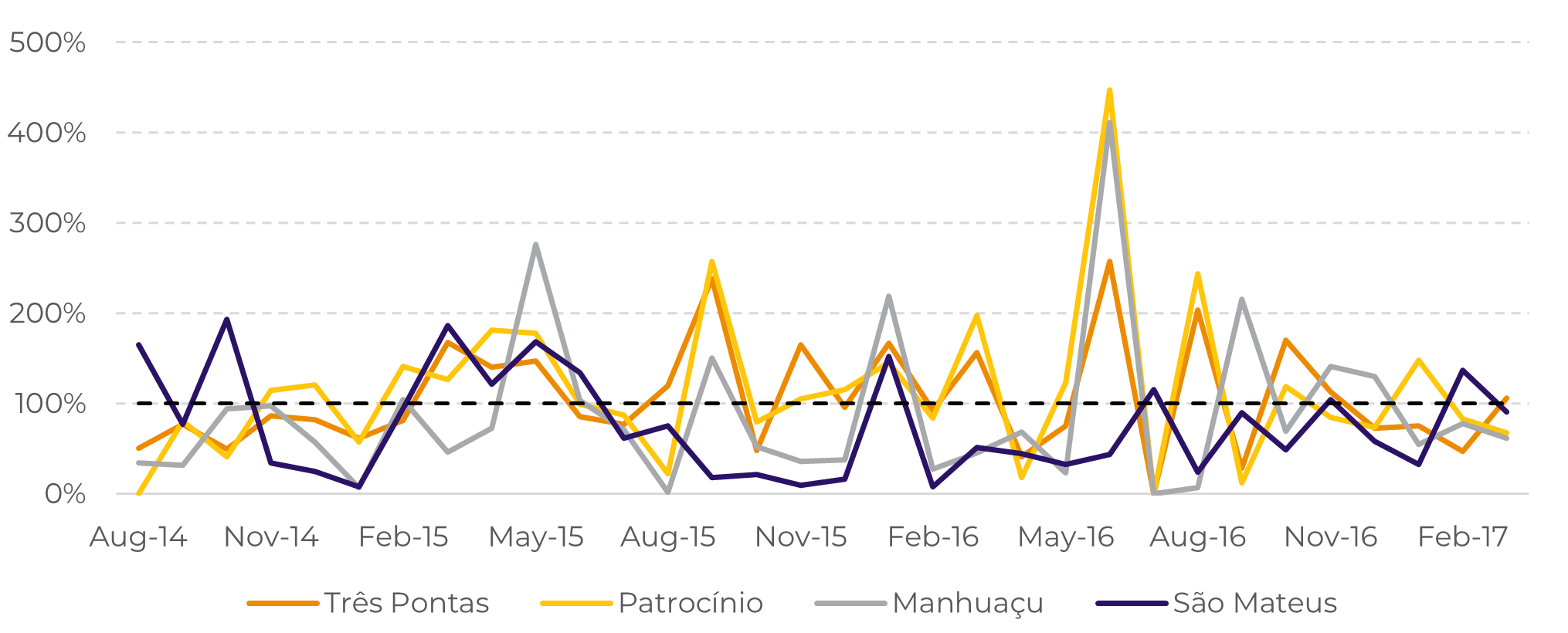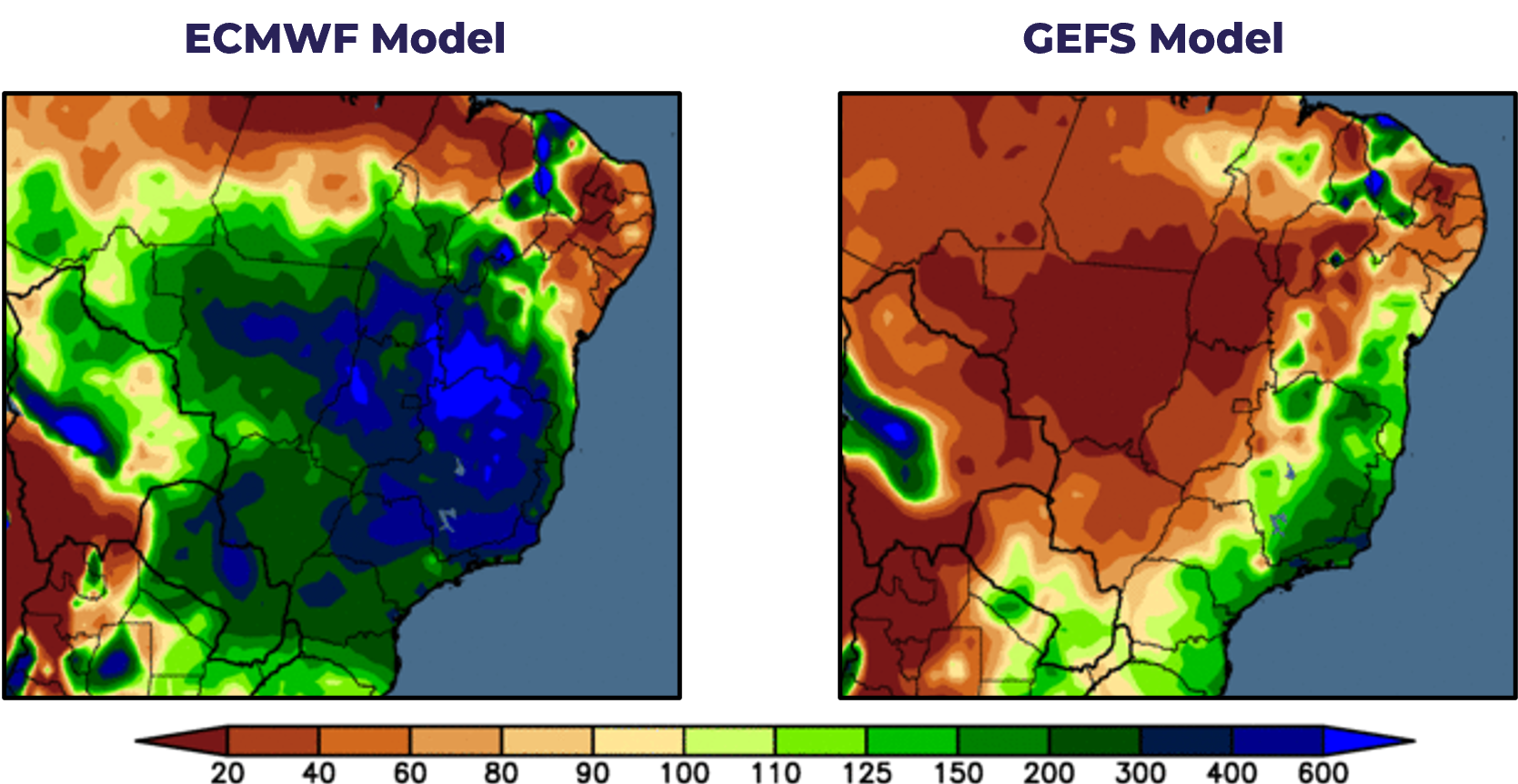
Aug 25
Coffee Weekly Report - 2023 08 25
Back to main blog page
- As Brazil's harvest enters its final stages and El Niño continues to influence conditions, the focus remains on assessing potential impacts on the upcoming 24/25 Brazilian coffee crop.
- The distinctive effects of El Niño on various coffee-producing regions are evident through temperature and precipitation variations.
- Notably, regions like Zona da Mata and Espírito Santo are more susceptible due to experiencing higher temperatures and below-average rainfall levels.
- Analyzing the Normalized Difference Vegetation Index (NDVI), a key measure of crop health, suggests a positive outlook for yields in the forthcoming crop; however, this metric's predictive accuracy is challenged by exceptional past yields driven by factors beyond NDVI (18/19, 20/21).
- Upcoming weather becomes key in understanding 24/25’s potential: the rainfall forecast suggests that coffee areas will report rains well above normal from August 25 until the second week of September.
Unpacking El Niño's Impact on 24/25 Brazilian Crop
This week, coffee prices rebounded from the 145 c/lb level, as discussed in our previous report. Still, as the harvest reached its final stages in Brazil, and El Niño remains active, it’s vital to continue investigating the possible impacts that the phenomenon can have on the 24/25 Brazilian crop.
Chart #1 shows the average temperature anomaly, considering an important period for the coffee market: the last El Niño in the past decade with high intensity, that led to crop failures in both arabica and conilon.
For selected cities in major coffee-producing regions, El Niño had different impacts: for Três Pontas and Patrocínio, temperatures were higher than the average in 53% of the key flowering/cherry growth periods analyzed. For Manhuaçu and São Mateus, however, the shares are higher: 67% and 89%, showing that arabica areas in Zona da Mata and conilon areas in Espírito Santo may be more vulnerable to the phenomenon than the remaining areas.
For precipitation, these areas are also under more threat: 78% of the key development periods in Manhuaçu and São Mateus received rainfall levels below average; in Três Pontas and Patrocínio, the shares were 67% and 44%, respectively.
For precipitation, these areas are also under more threat: 78% of the key development periods in Manhuaçu and São Mateus received rainfall levels below average; in Três Pontas and Patrocínio, the shares were 67% and 44%, respectively.
Image 1: Temperature Anomaly – Active El Niño during key development periods

Source: ICE
Image 2: Precipitation Anomaly – Active El Niño during key development periods

Source: ICE, Refinitiv
The combination of lower rainfall levels and higher temperatures may negatively affect coffee trees, and a good metric used to measure crop health is the NDVI (Normalized Difference Vegetation Index). Chart #3 shows the correlation between average NDVI levels between May and June of the previous year of every crop and yields for the South of Minas Gerais.
Intuitively, the higher the NDVI anomaly, the higher the expected yield. Some crops, such as 18/19 and 20/21, had much better results than expected by their NDVI levels – but that is due to other factors, such as a stronger on-year effect from previous cultural care and more sophisticated techniques.
Therefore, the weather seen in the recent past is also important to understand the potential of the next crop. Considering the average NDVI anomaly seen this year, yields will likely be higher than reported in 21/22, 22/23, and 23/24. However, the metric's predictive power is limited, as shown by the 18/19 and 20/21 crops, charging weather in the next quarter with a higher weight for the next crop’s development.
Image 3: Yields vs. NDVI Anomaly – South of Minas Gerais

Source: Refinitiv
Image 4: Precipitation Anomaly Forecast – Aug 25 to Sep 8 (% of normal)

Source: Refinitiv
In Summary
This week, coffee prices bounced back from 145 c/lb. Amid Brazil's advancing harvest and ongoing El Niño activity, it's crucial to examine potential impacts on the upcoming 24/25 Brazilian crop.
Regions like Zona da Mata and Espírito Santo might be more vulnerable due to high temperatures and low rainfall levels. The NDVI, a measure of crop health, correlates positively with yields in South Minas Gerais.
Still, while recent NDVI levels (which provide the best fit against yields) suggest better yields than the last three years, they may not encompass all influencing factors as seen in exceptional past crops (18/19, 20/21). Weather remains pivotal for the upcoming crop, with current weather forecast models suggesting heavy rainfall levels for the next two weeks.
Weekly Report — Coffee
Written by Natália Gandolphi
natalia.gandolphi@hedgepointglobal.com
natalia.gandolphi@hedgepointglobal.com
Reviewed by Pedro Schicchi
pedro.schicchi@hedgepointglobal.com
www.hedgepointglobal.com
Disclaimer
This document has been prepared by hEDGEpoint Global Markets LLC and its affiliates ("HPGM") exclusively for informational and instructional purposes, without the purpose of creating obligations or commitments with third parties, and is not intended to promote an offer, or solicitation of an offer, to sell or buy any securities or investment products. HPGM and its associates expressly disclaim any use of the information contained herein that may result in direct or indirect damage of any kind. If you have any questions that are not resolved in the first instance of contact with the client (client.services@hedgepointglobal.com), please contact our internal ombudsman channel (ouvidoria@hedgepointglobal.com) or 0800-878-8408 (for clients in Brazil only).
Contact us
hedgepointhub.support@hedgepointglobal.com
ouvidoria@hedgepointglobal.com
Funchal Street, 418, 18º floor - Vila Olímpia São Paulo, SP, Brasil
Check our general terms and important notices.
This page has been prepared by Hedgepoint Schweiz AG and its affiliates (“Hedgepoint”) solely for informational and instructional purposes, without the purpose of instituting obligations or commitments to third parties, nor is it intended to promote an offer, or solicitation of an offer of sale or purchase relating to any securities, commodities interests or investment products. Hedgepoint and its associates expressly disclaim any use of the information contained herein that directly or indirectly result in damages or damages of any kind. Information is obtained from sources which we believe to be reliable, but we do not warrant or guarantee the timeliness or accuracy of this information. The trading of commodities interests such as futures, options, and swaps involves substantial risk of loss and may not be suitable for all investors. You should carefully consider wither such trading is suitable for you in light of your financial condition. Past performance is not necessarily indicative of future results. Customers should rely on their own independent judgement and/or advisors before entering in any transaction.Hedgepoint does not provide legal, tax or accounting advice and you are responsible for seeking any such advice separately.Hedgepoint Schweiz AG is organized, incorporated, and existing under the laws of Switzerland, is filiated to ARIF, the Association Romande des Intermédiaires Financiers, which is a FINMA-authorized Self-Regulatory Organization. Hedgepoint Commodities LLC is organized, incorporated, and existing under the laws of the USA, and is authorized and regulated by the Commodity Futures Trading Commission (CFTC) and a member of the National Futures Association (NFA) to act as an Introducing Broker and Commodity Trading Advisor. HedgePoint Global Markets Limited is Regulated by the Dubai Financial Services Authority. The content is directed at Professional Clients and not Retail Clients. Hedgepoint Global Markets PTE. Ltd is organized, incorporated, and existing under the laws of Singapore, exempted from obtaining a financial services license as per the Second Schedule of the Securities and Futures (Licensing and Conduct of Business) Act, by the Monetary Authority of Singapore (MAS). Hedgepoint Global Markets DTVM Ltda. is authorized and regulated in Brazil by the Central Bank of Brazil (BCB) and the Brazilian Securities Commission (CVM). Hedgepoint Serviços Ltda. is organized, incorporated, and existing under the laws of Brazil. Hedgepoint Global Markets S.A. is organized, incorporated, and existing under the laws of Uruguay. In case of questions not resolved by the first instance of customer contact (client.services@Hedgepointglobal.com), please contact internal ombudsman channel (ombudsman@hedgepointglobal.com – global or ouvidoria@hedgepointglobal.com – Brazil only) or call 0800-8788408 (Brazil only).Integrity, ethics, and transparency are values that guide our culture. To further strengthen our practices, Hedgepoint has a whistleblower channel for employees and third-parties by e-mail ethicline@hedgepointglobal.com or forms Ethic Line – Hedgepoint Global Markets.Security note: All contacts with customers and partners are conducted exclusively through our domain @hedgepointglobal.com. Do not accept any information, bills, statements or requests from different domains and pay special attention to any variations in letters or spelling, as they may indicate a fraudulent situation.“HedgePoint” and the “HedgePoint” logo are marks for the exclusive use of HedgePoint and/or its affiliates. Use or reproduction is prohibited, unless expressly authorized by HedgePoint. Furthermore, the use of any other marks in this document has been authorized for identification purposes only. It does not, therefore, imply any rights of HedgePoint in these marks or imply endorsement, association or seal by the owners of these marks with HedgePoint or its affiliates.
We have updated our Terms & Conditions to reflect improvements to our platform, data handling practices, and the overall experience we provide to our clients.
To continue using the Hedgepoint HUB, please review and accept the updated terms.

